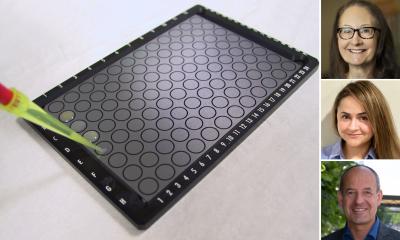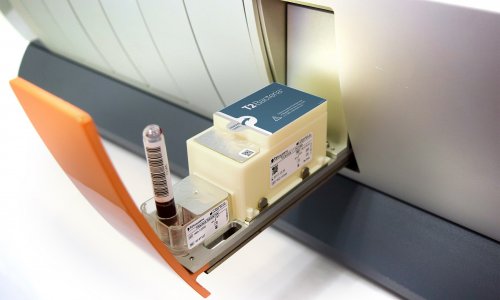Nosocomial infections
Hygiene begins between the ears
"Infection prevention and control is a matter of awareness and continuous education," says Dr Ernst Tabori, Medical Director of the German Consulting Centre for Hospital Epidemiology and Infection Control (BZH), at the University Hospital Freiburg, specialises in building hygiene in hospitals and outpatient healthcare facilities, as well as surgical units.
Report: Anja Behringer

Originating in the 19th century, the large hospital complexes in Berlin, Hamburg and Munich no longer meet the demands of modern medicine. Whilst the pavilion-type structures of the Rudolf Virchow Clinic in the grounds of Berlin’s Charité Hospital may have been considered exemplary 150 years ago – being copied by hospitals worldwide – modern healthcare needs short distances and central treatment complexes. The Nickl Architectural Practice initially made its name with a new design for the University Hospital Hamburg-Eppendorf. Various pavilions were converted for different types of use and some of the old buildings were demolished to make way for the dominant, main new structure.
However, according to Professor Christine Nickl ‘Many old hospitals are beyond a cure’ because of contamination with pathogens, right down in the pipework and wiring and also due to built in materials such as asbestos, at the time of construction considered harmless.
Her architectural practice is now also in demand abroad. The new build and redesign of Frankfurt’s University Hospital was undertaken based on the healing architecture criteria. The architects developed ten criteria, such as orientation within the building, which create trust in people; the architecture is never anonymous but always personal. There is a need for individual, one-bed rooms and the appropriate design logistics to connect these individual rooms with one other, creating adaptable spaces between them. According to Professor Nickl, this is a current issue. ‘We need the smaller spaces between rooms, which allow us to quickly react to changes in hospitals.’ She therefore advocates modular design.
Modular for fast reaction to change
This must not be confused with the type of modular design presented by numerous firms at the specialist meeting on Design and Operation of Hospitals, held at the Management Forum Starnberg, in University Hospital Munich. Fast increases in capacity, refurbishment of old buildings or contingency rooms during renovations – numerous solutions are available at various levels of cost.
Requirements in this field are very individual. Finding a customised solution for restoration or modernisation initially requires analysis of the current building portfolio, so that appropriate investment decisions can be made.
The CalCon Group, founded in 1999 as a spin-off from the Fraunhofer Institute for Building Physics, has developed software called ‘epiqr’ for portfolio assessment. The software collects just a few geometric parameters from any building portfolio and assesses only the most important building blocks as to their condition. With the help of statistical projections the system then calculates the materials required and the cost of respective structural measures. An acquisition effort of only 20% achieves a data accuracy of 80%.
The results are displayed in the ‘epiqr-diagram’ so that the customer can see, at a glance, where building priorities should be. The structural measures and costs database integrated into the system then determines the respective costs the customer can expect once the structural measures have been selected from those stored in the database.
Once the structural measures commence everyone’s attention should be on the internal design. As the changed process logistics affect daily routines, infection prevention and control must be a priority during renovations. In the chaos that develops during assumed short-term construction works, medical equipment has been known to have been moved out of operating theatres and stored in hallways, or sterile equipment may end up next to cleaning agents in storerooms.
Building hygiene
Dr Ernst Tabori, Medical Director of the German Consulting Centre for Hospital Epidemiology and Infection Control (BZH), at the University Hospital Freiburg, specialises in building hygiene in hospitals and out-patient healthcare facilities, as well as surgical units. ‘Infection Prevention and Control,’ he says, ‘is a matter of awareness and continuous education’. As far back as the 19th century, Ignaz Semmelweis was able to reduce maternal mortality rates in Vienna significantly through the simple measure of hand washing.
However, these days this appears to have disappeared from our consciousness, as the disinfectant dispensers visible on all wards do not reduce the contamination of door handles and other surface in the hospital with germs. Says Tabori: ‘We have moved along the way a little bit but haven’t quite arrived.’ Why? Lack of time? Ignorance? Lack of staff? The hospital infection control specialist believes that, even in modern buildings, the hospital pathogens infection rate cannot be further reduced because two thirds of all these pathogens come from the patients themselves. Therefore the term ‘indirect contact infection’ is imprecise and out-dated.
One solution could be for their general practitioners (GPs) to examine patients for pathogens before hospital admission, as carried out in the Netherlands. Alternatively, new admissions could be separated from other patients until the results of their infection status are known.
However, even small building-related issues can help, such as installing several, smaller wash basins in different locations rather than central washrooms with many basins for instance. Electronic water installations are susceptible to legionella, and the installation of elbow levers instead of water taps avoids contact with germs. There are many, detailed examples relating to water and air systems.
Specialists at the BZH can answer all enquiries on these subjects. As so nicely put by Ernst Tabori: ‘Hygiene begins between the ears’.
PROFILE:
Ernst Tabori MD has been Medical Director of the German Consulting Centre for Hospital Epidemiology and Infection Control at University Hospital Freiburg for the past 17 years. He is also a specialist in building hygiene for hospitals and out-patient healthcare facilities as well as for infection prevention and control in surgical units.
28.04.2015











